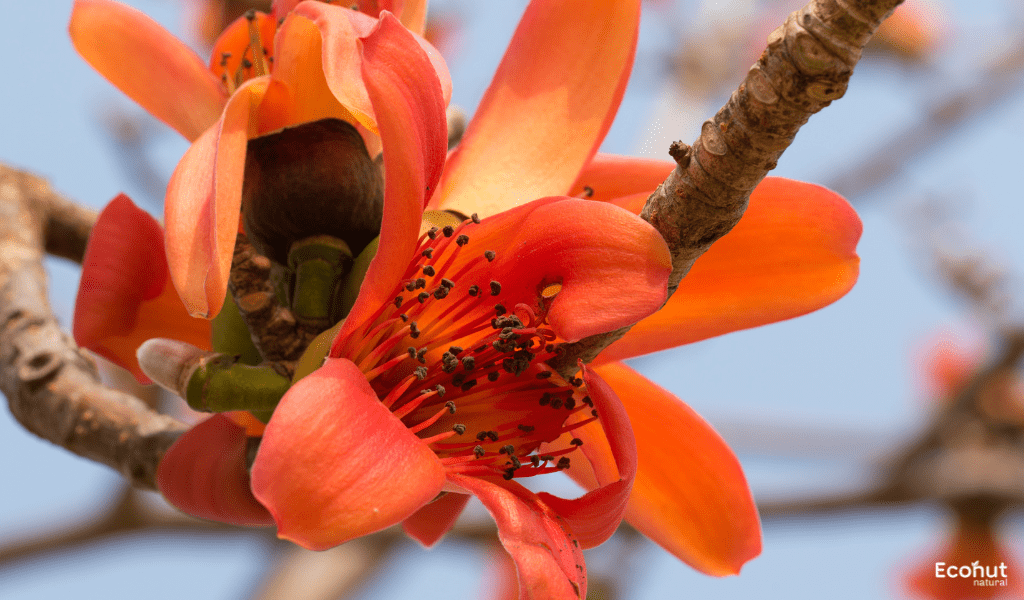Shalmali (Salmalia malabarica), a very useful herb used in Ayurvedic treatment, is also referred to as the Indian Kapok Tree, the Silk Cotton Tree, Semal, Buruga, Sittan, Unnamurika, or Sanmali. It is known as the king of the forest due to its immense stature and magnificent flowers. Shalmali’s native countries are India and Burma. It is considered a sacred tree in India.
Silk Cotton Tree (Salmalia malabarica) is one of the very useful Ayurvedic herbs, used for the treatment of dysentery, diarrhea, hemoptysis, influenza, acne, pimple, and menorrhagia.
Description
Nearly every part of the tree, including the flower, gum, stem bark, petiole, peduncle, and thorns, is used in Ayurveda because of its therapeutic properties. According to Ayurveda, Shalmali balances the Pitta and Vata doshas. It’s powerful and has a harsh taste.
Botanical Name:
Salmalia malabarica
Family:
Bombacaceae
Leaves:
Due to their deciduous nature, the leaves drop in the winter. Large and palmately complex, they have five to seven leaflets extending outward from a central point. Every leaflet features a smooth edge, a pointy tip, and an oval form.
Flowers:
The blossoms measure about 7 inches in width and 6–7 inches in length. Five satiny, reddish-purple, and occasionally white petals make up the flowers on this shrub. Flowers on this plant: January to March. Fruits shaped like balls and filled with substance resembling cotton are produced by this tree between March and April.
Fruits:
Fruits are long-between five and seven centimeters—oval or spherical, and they have five chambers.
Trunk:
The Shalmali tree has a long, robust trunk that can grow up to 125 feet in height and 20 feet in circumference. The many spiral thorns that cover the grayish-brown bark act as a barrier against herbivores.
Habitat:
Shalmali’s native country is Burma, India. In the hottest parts of India, this plant may thrive up to 1500 meters in elevation. It is also extensively planted along roadsides, in gardens, and by rivers in deciduous woods throughout the Indian peninsula.
Parts Used:
- Roots
- Flowers
- Leaves
- Gum
- Fruits
- Seeds
- Thorns
Dosage:
- Root powder: 6-12 g
- Gum: 1-3 g
- Fruit powder: 1-3 g
- Infusion of flower: 12-20 g
Chemical Constituents
Shalmali’s primary chemical components include hydroxycadalene, hentriacontane, lupeol, beta-sitosterol, and glucosides. In addition, it contains anti-diarrheal, anti-dysentery, anti-microbial, antipyretic, stimulant, astringent, and tonic qualities.
Common name
Silk cotton tree, Kapok tree
Sanskrit Synonyms
Picchila – Juice released by Salmali is sliy
Kantakadya (has thorns) – branches are studded with prickles
Tulaphala – Fruit has cotton like substances
Manadruma, Shirajivika – Salmali is a tall and long lived tree
Mocha – Salmali releases juice which is called mocha
Poorani – Juice is slimy
Bahuvirya – Salmali is very efficacious drug
Raktapushpa(red flower) Sthirayu
Other Language Names of Shalmali (Silk Cotton Tree)
Manipuri name – Tera
Assamese name – Simolu
Telugu name – Buruga
Vietnamese name – Hoagao
Greek name – Vomvax malvarikos
Portuguese name – Painiera-vermehla-da
Tamil name – Sittan, Sanmali, Llavam
Gujarati name – Shimalo
English name – Indian Bombax
Sanskrit name – Kantakadya, Mocha, Raktapushpa, Sthirayu
Hindi name – Shalmali, Semal
Malayalam name – Mullilavu
Bengali name – Shimul
Telugu name – Buruga
Urdu name – Sumbal
Marathi name – Safetasarava
Sinhala name – Katulmbul
Scientific Classification
| Kingdom | Plantae |
| Division | Magnioliophyta |
| Order | Malvales |
| Family | Bombacaceae |
| Genus | Bombax |
| Species | B. ceiba |
Ayurvedic Properties
Rasa – Kashaya (Astringent taste).
Guna (qualities) – Snigdha (Oiliness) and Laghu (Light to digest)
Veerya – Sheeta (The herb is cold in potency).
Vipaka – Madhura (sweet) (It undergoes sweet taste conversion after digestion)
Shalmali (Silk Cotton Tree) Uses
- The plant’s fruits have a diuretic effect that is particularly beneficial for kidney issues and bladder inflammation. Disorders associated to calculi are also treated with it.
- The plant’s leaves have anti-inflammatory, hypotensive, and hypoglycemic qualities. Because of its anti-inflammatory qualities, it keeps the body from inflaming and swelling.
- Silk Cotton Tree roots and bark help the body absorb nutrients better and relieve Pitta.
- The plant’s leaves have anti-inflammatory, hypotensive, and hypoglycemic qualities. Because of its anti-inflammatory qualities, it keeps the body from inflaming and swelling.
- The plant’s bark is particularly advantageous to the male reproductive system. The bark of stems is styptic and demulcent. It is also helpful for a wound that is healing and stops bleeding.
Shalmali (Silk Cotton Tree) Benefits
Beneficial for curing wounds:
Shalmali’s gum and bark are rich in wound-healing, antimicrobial, and antipyretic qualities. Wounds can be quickly healed by applying it to the damaged region. Bleeding is also stopped by it.
Shalmali as a diuretic:
Shalimali is a highly effective diuretic. Patients with limited urine output are given the blossoms of this plant. Additionally, it is used to treat conjunctivitis and splenomegaly.
Shalmali as an aphrodisiac:
Shalmali has strong aphrodisiac properties. It is quite advantageous for the reproductive system of men. Semen produced from this herb is higher-quality and produces more of it. Additionally, it treats nocturnal emission.
Treatment of dysentery:
The active ingredients of Shalmali root are used to cure hemorrhoids, piles, dysentery, and diarrhea. In addition, it works well for treating other chronic illnesses like pulmonary tuberculosis.
Don’t miss: Hadjod (Cissus Quadrangularis) – Uses, Benefits & Side Effects
Shalmali (Silk Cotton Tree) Side Effects
Breastfeeding:
Shalmali’s safety for nursing mothers is unknown; it’s advisable to avoid it if you’re nursing.
Allergic reactions:
Even though it is rare, some people may have allergies to Shalmali or any of its ingredients. Shalmali should not be used if you have rash, irritation, or trouble breathing; instead, stop using it and get medical help right once.
Dosage issues:
Depending on Shalmali’s form (powder, extract, etc.) and intended purpose, there may be differences in the recommended dosage. Excessive use may raise the possibility of negative effects.
Conclusion
Disorders associated to calculi are also treated with it. Additionally, the plant’s gum has some excellent therapeutic effects on hemoptysis, pulmonary TB, influenza, enteritis, burning feeling, and dysentery. The plant’s leaves are hypotensive, hypoglycemic, and have anti-inflammatory qualities.
FAQS
What advantages does Shalmali offer?
It is applied to leukorrhea in order to treat and control it. Additionally, it helps combat skin irritation, tissue redness, and burning or itchy sensations. Salmalia roots are styptic and can be applied topically to wounds, diarrhea, and menorrhagia infections.
What are the uses of Silk Cotton Tree?
The fibers, known as kapok in Asia, are utilized as filler in mattresses and pillows, as well as for insulation and cushioning in sleeping bags and life preservers. The tree, which is valued for its honey, was frequently placed in the middle of plazas in Puerto Rico as shade.
What is the use of silk cotton tree for skin?
Leaves are used as a skin-outbreak remedy. The gum of this plant is used to relieve searing pain and to cure enteritis, pulmonary tuberculosis, influenza, hemoptysis, and dysentery. Thorn of the stem bark paste is an external treatment for acne and pimples.

